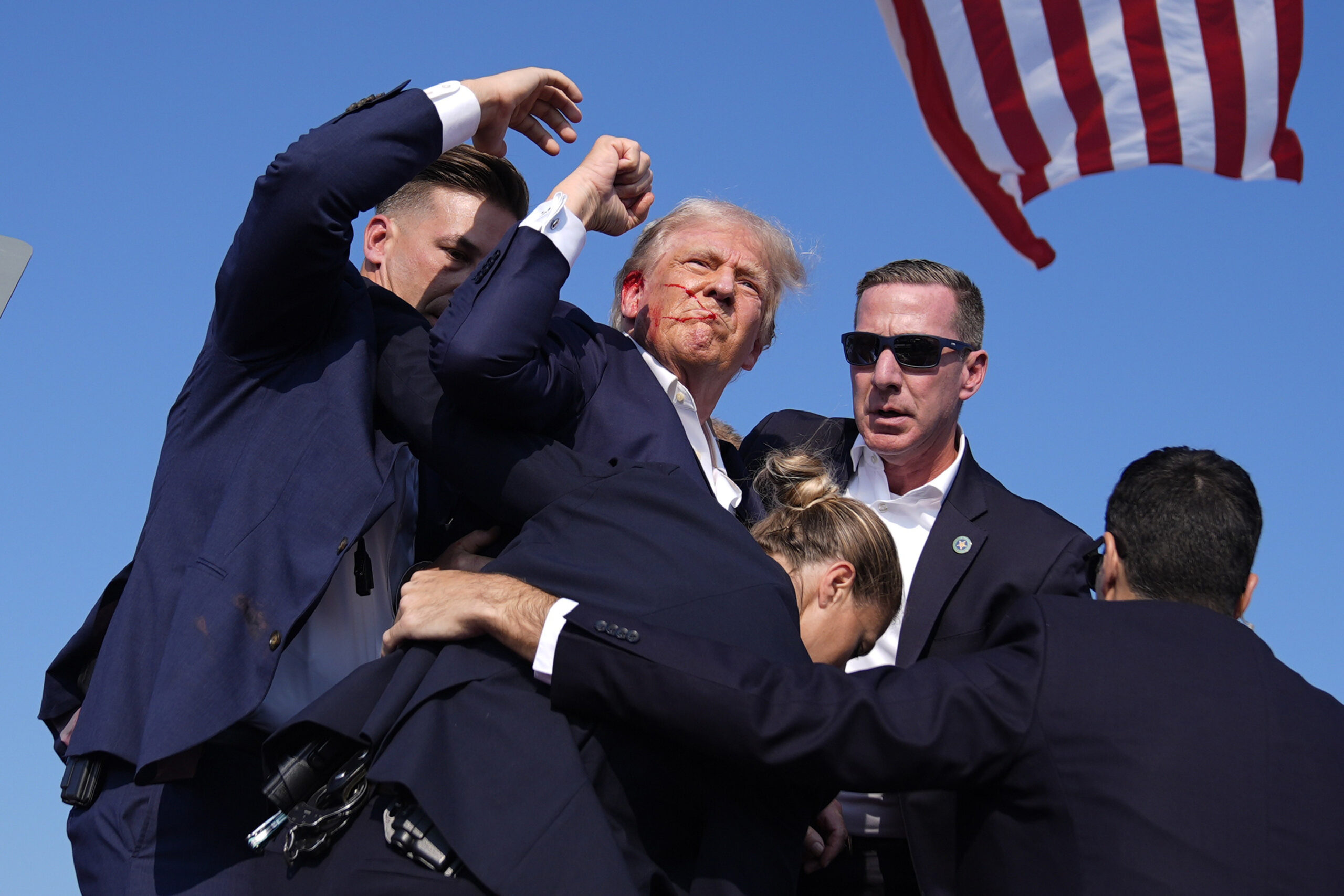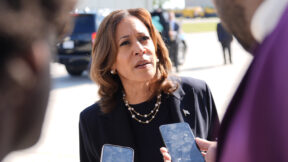
AP Photo/Evan Vucci
First, the sound of muffled bangs rang out. Pop, pop, pop. Donald Trump, speaking to a crowd of supporters in Butler, Pennsylvania, grabbed his right ear and ducked. The crowd behind him, in a state of shock, froze.
In the telling of one witness who spoke with ABC News in the aftermath, the “joyful” rally was pierced by those “popping sounds.”
“None of us really registered at the time that all these people were saying ‘get down!’ ‘get down!'” the witness said, underscoring the climate of confusion that pervaded the rally gone wrong.
Soon after, the news would report that those sounds – pop, pop, pop – were gunshots. One bullet pierced Trump’s ear, leaving him bloodied on the stage. One rally-goer was killed and two others were critically wounded. Within seconds, the gunman had been shot dead by snipers. But as Trump was rushed to an idling SUV by a mob of Secret Service agents, the press, like the public, had little clarity on what exactly had transpired.
The drought of information present in early coverage of the shooting has sparked widespread condemnation of the press. Much of the whining fixated on a lack of causal language in the first pass reporting.
Someone tries to assassinate the presumptive GOP candidate for president. And behold, your media:
WaPo: “loud noises”
CNN: “Trump falls”
NBC: “popping noises” pic.twitter.com/xeYRAlWFrM— Rachel Bovard (@rachelbovard) July 13, 2024
unbelievably mendacious coverage by the disgusting @AP pic.twitter.com/UuLOx3QQU8
— paige (@midwesterneur) July 13, 2024
Breaking news events — particularly one as fraught as a live event involving the shooting of a former president — are difficult to cover. Information is fluid and rumors spread fast. Mistakes were made Saturday night: some outlets inaccurately reported two attendees had been killed. The New York Post inaccurately reported the gunman was Chinese. TMZ cited sources who said Trump was grazed not by a bullet but by a shattered teleprompter. So many users on X, formerly Twitter, stated with certainty the gunman was an Italian man named Mark Violets that his name trended on the platform.
The media learns information incrementally, and publishes what it can confirm. That’s why in the aftermath of the shooting, initial reports brought news of the popping sounds, the blood dripping down Trump’s face, the mad dash to the SUV.
In these kinds of news environments, the best practice for the press is to report what it knows. Often, media critics of limited imagination condemn the press for not reporting what they believe it should assume. It might feel good to see a headline advance your preferred view of what happened, but playing fast and loose with the proven facts serves only to erode the bond of trust between the media and the reader.
All of these news outlets that drew fury for that early reporting quickly updated their stories or published new ones describing the shooting faithfully and in great detail. Indeed, the AP headline above that inspired a critic to label the outlet “disgusting” and “unbelievably mendacious” was soon changed from “Donald Trump has been escorted off the stage by Secret Service during a rally after loud noises ring out in the crowd,” to “Trump injured but ‘fine’ after attempted assassination at rally, shooter and one attendee are dead.”
There is a reason the press calls murderers “suspected” or “alleged” murderers before they’ve been tried and convicted. There is a reason that, when popping sounds are heard at a rally and blood streams down a former president’s face, the media reports just that – and doesn’t jump to the conclusion that those popping sounds were gunshots and the blood caused by a bullet. The reason is an absence of certainty.
Critics have also complained that some outlets refrained from immediately deeming the shooting an “assassination attempt.” But as NBC’s Kelly O’Donnell explained: “Our reporting guidelines require that we not use that term until law enforcement describes it as an assassination attempt if/when the investigation supports that designation. It is a measured approach for accuracy.”
This is standard news writing. It’s a common practice for a reason. It’s the same reason law enforcement exercises caution when revealing information to the public: so that they get the facts right. Even Trump himself, in a statement issued Sunday afternoon, referred to the shooter as a “potential assassin.” Still, O’Donnell faced the wrath of media critics, from frothing conservative commentators like Stephen Miller, for the sin of caution.
“There is no guideline that stops you from reporting what was clearly on video (and backed by dozens of on the record witnesses) just because the government hadn’t used the magic words yet,” fumed one writer from the hollowed-out pro-Trump blog RedState. “What a joke. Are you a news organization or stenographers? Don’t answer that, we know.”
I would ask if the pundit responsible for that comment ever learned how to write about news, but the answer is evident. Most news outlets, regardless of their place on the ideological spectrum, rely on confirmation when reporting on crimes. The reasons are manifold and manifest. Politico reporter Natalie Fertig explained them well in a thread on X.
Everyone might assume the shooting was an assassination attempt. It’s the obvious conclusion to draw considering the facts on the ground. Still, outlets like the Associated Press wisely use hedged language when describing such events (emphasis mine):
Law enforcement officials were working Sunday to learn more about the 20-year-old Pennsylvania man who they say tried to assassinate former President Donald Trump at a campaign rally and to determine what drove him to open fire, killing one spectator.
The impulse towards the kind of bad media criticism I describe here is a bipartisan affliction. When George Floyd was killed by Derek Chauvin in 2020, many on the left furiously demanded the media label Chauvin a murderer. It was caught on camera, they insisted. But Chauvin had not been convicted of murder, and the media rightly exercised caution in labeling him as such until a jury reviewed the evidence and delivered its verdict.
It’s the same kind of tedious media criticism that anti-Trump liberals have lobbed at the press for nearly a decade: You must call Trump a liar and a racist. Deeming his fact-challenged statements to be merely false claims and his offensive rhetoric to be racially-charged is a thinly-veiled attempt to defend Trump. The debate around whether to use cautious or more muscular language has raged – in the pages of the New York Times and elsewhere – since Trump launched his truth-stomping presidential campaign in 2016.
I call this media criticism tedious because it takes issue with an imaginary consequence of such restrained reporting. Does anyone reading the New York Times think Trump is a paragon of honesty? Did anyone who read its sweeping but measured coverage of the shooting on Saturday night conclude Trump was not the victim of an assassination attempt?
Imagine the following scenario. Pops ring out at the rally. Trump clutches his ear and falls to the ground, before standing up surrounded by Secret Service agents. The media rushes out the breaking news: Trump Shot By Would-Be Assassin. Then, say that turned out not to be true; the pops were fireworks, the gash on Trump’s ear caused by shards of a shattered teleprompter.
The exact same critics attacking the press now would be screaming — or tweeting — that the media tried to fuel hysteria and incite another Jan. 6 by riling up the MAGA crowd with false reports their hero went down.
A media that exercises restraint is a good media. It often fails to live up to that standard, but the argument that it should be more reckless in its coverage, not less, is one that will lead to worse, not better reporting.
This is an opinion piece. The views expressed in this article are those of just the author.






